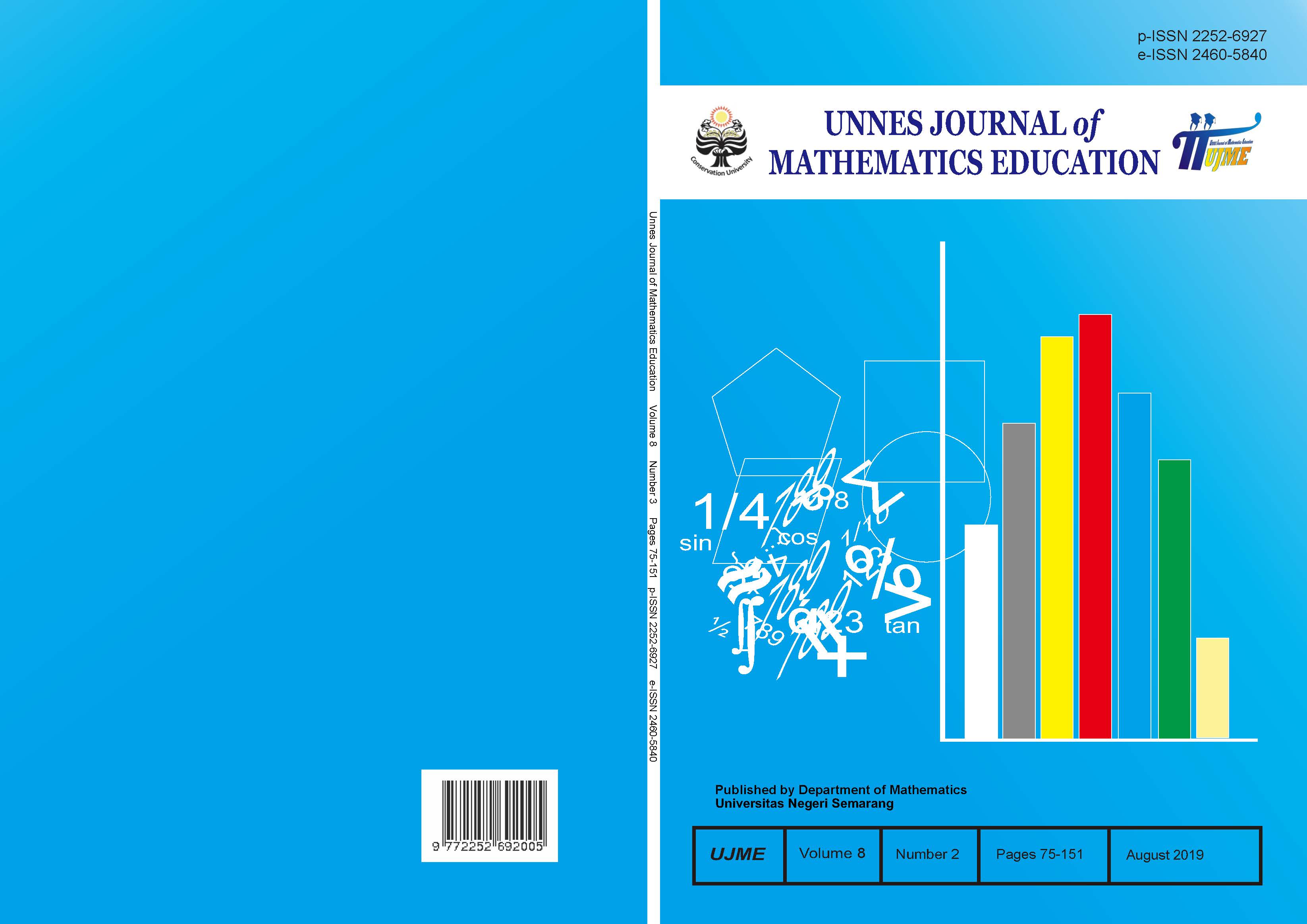Students' creative thinking ability in solving problems with double loop problem solving model
##plugins.themes.academic_pro.article.main##
Abstract
This study aims to test the completeness students' creative thinking abilities of Double Loop Problem Solving for, whether students' creative thinking skills in Double Loop Problem Solving learning are better than Problem Based Learning, the effect of learning independence on students' creative thinking abilities with Double Loop Problem Solving, and describing creative thinking abilities students in terms of learning independence. This research used mixed methods with sequential explanatory design. The quantitative research design used was Quasi-Experimental Design in the form of Posttest-Only Control Group Design The subjects of this study were six students of VIII C Class in SMPN 35 Semarang in the even semester of academic year 2018/2019. The data collection techniques used were: tests, questionnaires, and interviews. The results showed that: (1) students 'creative thinking ability in Double Loop Problem Solving learning achieves classical completeness, (2) students' creative thinking ability with the Double Loop Problem Solving model is better than Problem Based Learning, (3) learning independence has a positive effect on students' creative thinking ability in Double Loop Problem Solving learning, (4) students' creative thinking skills in terms of learning independence in Double Loop Problem Solving learning model as follows (a) Subjects with low group learning independence are less able to solve problems correctly and smoothly, with the different ways or answers, with their own thoughts, and with details; (b) Subjects of medium group learning independence are able to solve problems correctly and smoothly, less able to solve problems in different ways or answers, able to solve problems with their own thoughts, and less able to solve problems in detail; (c) Subjects of high group independent learning above are able to solve problems correctly and smoothly, with different ways or answers, with their own thoughts, and with details
##plugins.themes.academic_pro.article.details##
References
Allen .M.J & Yen. (1979). Introduction to Measurement Theory. Monterey: Brooks Cole Publishing Company
Arifah, Y. N., Rochmad., & Sugiman. (2016). Keefektifan Model Pembelajaran Core Berbantuan Strategi Studi Kasus Terhadap Kemampuan Berpikir Kreatif Siswa SMP. Unnes Journal of Mathematics Education, 5(2): 125-130
Azwar, S. (2012). Penyusunan Skala Psikologi Edisi 2. Yogyakarta: Pustaka Pelajar.
Creswell, J.W. (2012). Educational Research Planning, Conducting and Evaluating Quantitative And Qualitataive Research Fourth Edition. Boston: Pearson Education.
Creswell, J.W. (2016). Research Design: Pendekatan Metode Kualitatif, Kuantitatif dan Campuran. Yogyakarta: Pustaka Pelajar.
Dewi, N.R. & Kusumah, Y.S. (2014). Developing Test of High Order Mathematical Thinking Abilityin Integral Calculus Subject. International Journal of Education and Research, 12(2): 101-108
Fajriah, E., Mulyono., & Asikin, M. (2019). Mathematical Literacy Ability Reviewed from Cognitive Style of Students on Double Loop Problem Solving Model With RME Approach. Unnes Journal of Mathematics Educational Research, 8(1):57-64
Huda, M. 2013. Model-Model Pengajaran Dan Pembelajaran. Yogyakarta: Pustaka Pelajar.
Jufri, L. H. (2015). Penerapan Double Loop Problem Solving Untuk Meningkatkan Kemampuan Literasi Matematis Level 3 Pada Siswa Kelas Viii Smpn 27 Bandung LEMMA, 2(1): 52-62.
Kurniasari, I., Dwijanto, Soedjoko, E. (2014). Keefektifan Model Pembelajaran MMP dengan Langkah Pemecahan Masalah Polya Terhadap Kemampuan Berpikir Kreatif Siswa Kelas VII. Unnes Journal of Mathematics Education, 3(2): 145-150
Lestari, D. I., Supriyono., Sugiharti E. (2014). Keefektifan Pembelajaran Mea Berbantuan Lembar Kegiatan Peserta Didik Terhadap Kemampuan Berpikir Kreatif. Unnes Journal of Mathematics Education, 3(1): 8-14
Mahmudi, A. (2008). Tinjauan Kreativitas Dalam Pembelajaran Matematika. Jurnal Pendidikan Matematika UNY, 4(2): 37-49.
Mursidik, E. M., Samsiyah, N., & Rudyanto, H. E. (2015). Kemampuan Berpikir Kreatif dalam Memecahkan Masalah Matematik Open-Ended Ditinjau dari Tingkat Kemampuan Matematika pada Siswa Sekolah Dasar. Journal Pedagogi, 4(1): 23-33
Nasution, P. R., Surya, E., & Syahputra, E. (2015). Perbedaan Peningkatan Kemampuan Berpikir Kreatif Matematis dan Kemandirian Belajar Siswa pada Pembelajaran Berbasis Maslah dan Pembelajaran Konvensional di SMPN 4 Padangsidimpun. Jurnal Unimed, 8(3).
Nur, I. R. D. (2016). Meningkatkan Kemampuan Berpikir Kreatif Matematis dan Kemandirian Belajar Siswa Dengan Menggunakan Model Pembelajaran Brain Based Learning. Jurnal Pendidikan Uniska, 4(1):26-41.
Rahayu, I., Suyitno, H., & Wardono. (2014). Pembelajaran Matematika Model Double Loop Problem Solving dengan Pendekatan PMRI Bermuatan Karakter untuk Meningkatkan Kemampuan Pemecahan Masalah. Unnes Journal Of Mathematics Education, 3(1):50-55
Peraturan Menteri Pendidikan dan Kebudayaan Republik Indonesia Nomor 20 Tahun 2016. Tentang Standard Kompetensi Lulusan Kurikulum 2013. (Decree of The Indonesian Minister of Education and Culture Number 20, 2016).
Siswono, T. Y. E. (2011). Level of student’s creative thinking in classroom Mathematics. Educational Research and Review, 6 (7). 548-553.
Sugiyono. (2017). Metode Penelitian Pendidikan. Bandung: Alfabeta
Sumarmo. (2011). Kemandirian Belajar: Apa, Mengapam dan Bagaimana Dikembangkan pada Peserta Didik. Makalah Seminar Pendidikan Matematika. Yogyakarta: Universitas Negeri Yogyakarta.
Zimmerman, B. J. (1989). A Social Cognitive View of SelfRegulated Academic Learning. Journal of Educational Psychology, 31 (3): 329-339.
